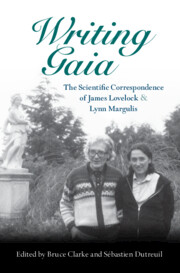Book contents
- Writing Gaia: The Scientific Correspondence of James Lovelock and Lynn Margulis
- Reviews
- Writing Gaia: The Scientific Correspondence of James Lovelock and Lynn Margulis
- Copyright page
- Epigraph
- Table of Contents
- Figures
- Contributors
- Foreword by James Lovelock
- Preface
- Acknowledgements
- Introduction
- Part I 1970–1972
- Part II 1973–1979
- Part III 1980–1991
- 1980
- 1981
- 1982
- 1983
- 1984
- 1985
- 1986
- 1987
- 1988
- 1989
- 1990
- 1991
- Part IV 1992–2007
- Part V Commentaries on Lovelock and Margulis
- Glossary of Names
- Glossary of Terms
- Bibliography
- Index
1982
from Part III - 1980–1991
Published online by Cambridge University Press: 28 July 2022
- Writing Gaia: The Scientific Correspondence of James Lovelock and Lynn Margulis
- Reviews
- Writing Gaia: The Scientific Correspondence of James Lovelock and Lynn Margulis
- Copyright page
- Epigraph
- Table of Contents
- Figures
- Contributors
- Foreword by James Lovelock
- Preface
- Acknowledgements
- Introduction
- Part I 1970–1972
- Part II 1973–1979
- Part III 1980–1991
- 1980
- 1981
- 1982
- 1983
- 1984
- 1985
- 1986
- 1987
- 1988
- 1989
- 1990
- 1991
- Part IV 1992–2007
- Part V Commentaries on Lovelock and Margulis
- Glossary of Names
- Glossary of Terms
- Bibliography
- Index
Summary
Toward the end of the 1970s, Lovelock brings his student, Andrew Watson, into the work on Gaia. He added him as coauthor to an earlier paper begun with Margulis, “Methanogenesis, fires and the regulation of atmospheric oxygen.”300 By the early 1980s, Lovelock and Watson were deep into the initial programming of Daisyworld and so moving away from Margulis’s own Gaian expertise and, one must also think, away from her professional preferences. It would appear that she made some draft contributions to the first fully developed professional essay on Daisyworld, “Biological homeostasis of the global environment: the parable of Daisyworld.”301 However, despite occasional expressions of encouragement, her enthusiasm for this turn of Gaian affairs was muted, as may be discerned in her candid Letter 133, in a less-than-complimentary comparison of Daisyworld to a heavily mathematical, implicitly neo-Darwinian formalization of population genetics known as the Hardy–Weinberg principle: “I think what you are doing for Gaia is exactly analogous to what Hardy and Weinberg did for population genetics. I suppose it will have the same bad effect too of generating the usual academic garbage.”302
- Type
- Chapter
- Information
- Publisher: Cambridge University PressPrint publication year: 2022



